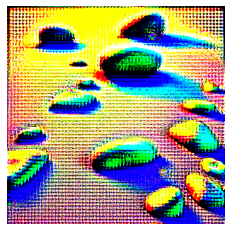@jenkspt This is very interesting! I failed to make RGB space optimization work too, but it seems latent space optimization can work well:
RGB space:

Latent space:

import math
from tqdm import tqdm
import torch
import torch.nn as nn
from nerf.sd import StableDiffusion, seed_everything
from torch.optim.lr_scheduler import LambdaLR
import matplotlib.pyplot as plt
def get_cosine_schedule_with_warmup(optimizer, num_warmup_steps, num_training_steps, num_cycles: float = 0.5):
def lr_lambda(current_step):
if current_step < num_warmup_steps:
return float(current_step) / float(max(1, num_warmup_steps))
progress = float(current_step - num_warmup_steps) / float(max(1, num_training_steps - num_warmup_steps))
return max(0.0, 0.5 * (1.0 + math.cos(math.pi * float(num_cycles) * 2.0 * progress)))
return LambdaLR(optimizer, lr_lambda, -1)
device = 'cuda:0'
guidance = StableDiffusion(device)
guidance.vae.encoder = None
prompt = 'pineapple'
text_embeddings = guidance.get_text_embeds(prompt, '')
guidance.text_encoder.to('cpu')
torch.cuda.empty_cache()
seed_everything(42)
latents = nn.Parameter(torch.randn(1, 4, 64, 64, device=device))
optimizer = torch.optim.AdamW([latents], lr=1e-1, weight_decay=0)
num_steps = 1000
scheduler = get_cosine_schedule_with_warmup(optimizer, 100, int(num_steps*1.5))
for step in tqdm(range(num_steps)):
optimizer.zero_grad()
t = torch.randint(guidance.min_step, guidance.max_step + 1, [1], dtype=torch.long, device=guidance.device)
with torch.no_grad():
# add noise
noise = torch.randn_like(latents)
latents_noisy = guidance.scheduler.add_noise(latents, noise, t)
# pred noise
latent_model_input = torch.cat([latents_noisy] * 2)
noise_pred = guidance.unet(latent_model_input, t, encoder_hidden_states=text_embeddings).sample
# perform guidance (high scale from paper!)
noise_pred_uncond, noise_pred_text = noise_pred.chunk(2)
noise_pred = noise_pred_uncond + 100 * (noise_pred_text - noise_pred_uncond)
w = (1 - guidance.alphas[t])
grad = w * (noise_pred - noise)
latents.backward(gradient=grad, retain_graph=True)
optimizer.step()
scheduler.step()
if step > 0 and step % 100 == 0:
rgb = guidance.decode_latents(latents)
img = rgb.detach().squeeze(0).permute(1,2,0).cpu().numpy()
print('[INFO] save image', img.shape, img.min(), img.max())
plt.imsave(f'tmp_lat_img_{step}.jpg', img)The RGB-latent transition in stable-diffusion is distinct from imagen/ediffi, and it seems directly operating on the latent space is a better idea, like the recent latent-nerf.







(Awesome work here -- I saw there is already a paper out based on your work: latent-nerf)
As a sanity check I'm trying generate an image with "differentiable image parameterization" (DIP) and the SDS algorithm here's the MWE:
I ended up with this: "3D texture of pebbles"
I've tried using sigmoid activation for the image and various learning rates, but the images still come out super saturated.
The DreamFusion authors claim they were able to get similar DIP results as DDPM
My question is: were you able to get this working? Or do you have any suggestions/ideas to get quality similar to DDPM?